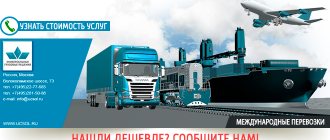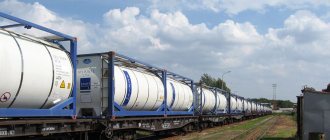Freight transportation plays an important role in the modern economy, having already formed a full-fledged industry. The need for cargo transportation carried out by various methods is only growing every year. Organizing the delivery of goods includes a number of mandatory procedures, and an important condition for its high-quality implementation is the safety of the delivered goods from the sender to the recipient, which can be fully ensured by container transportation.
Features of transporting containers by road.
The movement of goods can be carried out using sea, air, rail or road transport. Moreover, with the development of the automobile industry, the volume of cargo transportation has increased significantly. Despite the fact that road transport is much younger than rail and sea transport, it has firmly and confidently occupied a niche in this area. Transportation of containers by road has its own characteristics and requires compliance with the rules described in legislative acts, in principle the same as the movement of goods through other types of vehicles.
What it is
Road transport services for cargo transportation are the most in demand today and can be carried out either independently or as part of multimodal transportation, which is movement using different modes of transport. When delivering cargo over short distances, the choice of method for carrying out the process is obvious. Among various cargo transportation schemes, a profitable and effective solution is container transportation, which involves transporting goods in metal structures that do not require repacking along the route. It is possible to transport goods, including products that require special transportation conditions, using various vehicles depending on the type of cargo.
The method of container transportation is good not only for its high level of protection from damage during reloading and transportation, even under unforeseen circumstances along the route, but also for the convenience of loading and unloading. They are transported in special boxes by sea, air and land transport. This method is also very beneficial for multimodal transportation, since there is no need to move the cargo itself when changing vehicles, and only requires moving the container in which it is contained.
In addition to material benefits, the goals of preserving the contents are also pursued. The safety of the container, and at the same time the cargo itself, is ensured by fastenings that secure the structure. A key feature that also makes it possible to protect the goods from theft is its inviolability until the end of the journey, which guarantees the principle of sealing the box. The container is sealed by the sender and printed by the recipient, this minimizes the risk of content loss.
Container transportation by road also differs favorably from the body delivery method in that there is no need to unload and load the goods again along the route, even over long distances. The box does not need to be opened, and all information about the contents is available in the accompanying documentation. In addition, as a result of the absence of the need for repacking and ease of loading and unloading, precious time is saved, which is also important for the delivery of certain types of products, because speed is one of the components of a successful business, and in combination with other factors ensures an increase in cargo turnover within the country and abroad .
Air transportation
The rules for transporting food on an airplane are practically no different from those that apply during transportation by road. But there are a few additional points.
According to regulations, frozen meat and seafood should be delivered tightly packed using special thermal containers that maintain the required temperature.
The rules require that vegetables and fruits be transported in durable containers. Thanks to the packaging, the cargo does not deform and retains its consumer characteristics throughout the flight.
It is mandatory that the accompanying documentation be properly completed. You need to obtain veterinary certificates for the cargo and issue invoices.
If all the rules and regulations are followed, the regulatory authorities do not have any questions for the carrier. In this case, the goods will arrive at the consignee's warehouse exactly on time.
What kind of cargo can be transported?
Today, you can move goods not only within a city, region or country, but throughout the world. You can transport almost anything, of course, with the exception of items and substances prohibited by the state, such as weapons, ammunition, explosives, drugs, etc. It is also strictly forbidden to transport people in this way. Depending on the transfer method, there are certain rules that allow or prohibit the carriage of one or another type of cargo. Delivery of containers by road transport or other types of vehicles requires compliance with a number of conditions prescribed by law. In addition to the transportation of items prohibited on the territory of the country, the following are not allowed for container transportation by road:
- Any loads that can damage the structure;
- Cereals, bulk materials without packaging;
- Cargo that pollutes the container, as well as emitting a stench;
- Explosive, poisonous, toxic, radioactive substances.
Of particular importance for transportation in accordance with all the rules of the established regulations is the correct choice of the module in which the goods will be transported. Depending on the contents, different containers are used to ensure safe transportation conditions. Thus, goods can be transported by road in any type of module weighing from 2.5 to 24 tons, and the packaging is also intended for multimodal transportation.
Types of containers for transporting goods
Universal containers are used for goods that do not require special storage conditions. They have different types and dimensions that comply with accepted standards:
- Closed containers (the most popular are 20 and 40 foot boxes);
- Open containers with a removable top for oversized objects;
- Open platforms are intended for non-standard and large-sized cargo.
Containers are divided according to weight parameters:
- Low-tonnage (up to 2500 kg);
- Medium (up to 10,000 kg)
- Large-tonnage (over 10,000 kg).
Specialized containers are intended for contents that require special conditions for storage and transportation. These can be dangerous goods, liquids, bulk or other goods that require a special environment. Special containers can be of different types:
- Refrigerated trucks are intended for the transportation of perishable products that require maintaining a certain temperature, and are equipped with a refrigeration and heating unit;
- Isothermal - these are completely insulated containers, also capable of maintaining a constant temperature, but due to a thermally insulated body, and there are no sources of cooling or heating;
- Tanks for liquid cargo, including dangerous ones.
Placement of cargo is carried out strictly according to the rules provided by law. In the case of large-tonnage cargo, loading can be carried out using cranes provided that the container roof is mobile. After stowing the contents, the box is sealed by the sender, and together with the accompanying documentation, the goods are sent from the warehouse or from the door. Reverse manipulations with removing seals from locks and latches are performed by the recipient.
Fines
The peculiarities of road transport of goods are such that if a driver grossly violates the rules during transportation, he will face administrative liability in the form of a fine.
Types of violations and fine amounts
For violation of transportation rules during icy conditions, the fine can be no more than 500 rubles.
Violation of the rules for transporting heavy cargo may result in either a fine of 2.5 thousand rubles or deprivation of rights for up to 6 months. If the driver is an official, then the size of the sanction increases to 15 thousand rubles, and for a legal entity - up to 500 thousand.
If the weight of a heavy load is more than 5% higher than what is indicated in the documents, then the fine can range from 1 to 250 thousand rubles.
If the dimensions of large cargo exceed the dimensions by more than 1/5 or the weight by 20%, then the fine will be 3-4 thousand rubles. For officials, the sanction will be 25–30 thousand rubles, for legal entities – 300 thousand.
Fines are also provided for cases when, when transporting bulk cargo, it spills onto the road.
Requirements for transport and drivers
The type of transfer by road is carried out according to regulations, which include rules for transporting containers and requirements for vehicles, containers and persons who carry out delivery. To move some types of cargo, permitting documents from government organizations are required. Containers for transportation must be selected in accordance with the weight, dimensions and nature of the cargo. Goods that require special storage conditions are transported exclusively in vehicles equipped for this purpose (refrigerators, tanks, etc.). Various vehicles are used to transport containers; the transfer can be carried out in cars of a suitable brand and body type that are part of the transport:
- Trucks (flatbeds, usually used for delivering construction materials, and vans);
- Tractors used for towing trailers, semi-trailers, etc.;
- Trailers, semi-trailers traveling as part of a vehicle (road train);
- Specialized containers (refrigerators, isothermal bodies, tanks);
- Cargo can also be transported on platforms. This type is distinguished by an increased load capacity (up to 200 tons) and the presence of fasteners for securing the container. Large or non-standard cargo is loaded onto an open platform.
The sender loads the vehicle without involving the driver of the vehicle, except in situations where it is necessary to control the forklift, which is part of the vehicle’s equipment.
The driver is then obliged to inspect the loaded containers for defects and record compliance with technical and legislative standards. The rules for transporting containers require the following:
- The structure must be intact without any damage;
- Cleanliness of the container is required;
- Fasteners and other elements used must be in good working order;
- The load must be distributed throughout the box, large items in the center to avoid overweight. In this case, you need to retreat 15-20 cm from the door;
- When loading, it is important to take into account the weight of the cargo and container equipment; legally and technically, it is forbidden to overload the machine beyond its carrying capacity;
- It is necessary to ensure reliable fixation of the cargo inside the structure, as well as the container itself, in order to prevent the mobility of the goods while the vehicle is moving.
If it is impossible to comply with transportation rules, the sender of the cargo may refuse the service. The same applies to the carrier.
Air transportation
| Requirements for cargo weighing up to 32 kg | ||
| Load volume: up to 0.21 m³ | ||
| Dimensions of one cargo piece: up to 3 m | ||
| Weight of one cargo item: up to 32 kg | ||
| Requirements for cargo weighing from 32 kg | ||
| The dimensions of the cargo must not exceed the permissible dimensions length: up to 2 m width: up to 1 m height: up to 0.8 m | ||
| Weight of one cargo piece: up to 80 kg | ||
| Oversized cargo | ||
| The possibility of transporting heavy or large-sized cargo and the cost of their transportation must be previously agreed with specialists. | ||
If the cargo is a bulk substance or liquid, then it must have a safety passport or a document confirming the safety of the cargo for air transportation.
In order to avoid unwanted events during cargo transportation, we ask you to familiarize yourself with the special requirements,
requirements for air transportation of lithium ion batteries as part of equipment. The need to comply with them is dictated by concern for the safety of the cargo entrusted to us. Please be sure to inform PEK Company employees about the presence of devices equipped with batteries or accumulators of any type in your cargo.
General requirements for primary packaging for air transportation
Special requirements for cargo and packaging when transporting devices with lithium ion batteries by air
Prohibited
for air transportation: unicycles, Segways, hoverboards, electric scooters, portable chargers (power banks), electric children's toys.
Allowed
for air transportation: mobile phones, video cameras, cameras, portable music players and laptops.
Batteries are accepted for transportation only packaged, as part of or as a set with equipment; The power density of lithium-ion batteries should not exceed 20 watt-hours per cell or 100 watt-hours per battery.
Packaging requirements:
- packaging must consist of two layers: internal and external;
- the packaging must completely protect the cell or battery from any unwanted external influences;
- the equipment must be packaged in such a way as to prevent spontaneous operation during transportation.
Advantages of container transportation by road
The advantages of moving goods in containers are obvious. The cargo is maximally protected from damage, theft of property from the box, as well as other external factors, including the negative influence of weather conditions. Objects can be moved in this way using various means of the transport network, including several simultaneously along one route. Road transport of containers has become widespread today due to numerous advantages:
- Delivery can be made to almost any point, which is very convenient if there is no railway connection at the point of transfer/reception of cargo;
- Accuracy of calculations of transportation time and cost;
- High delivery speed;
- Ability to track goods along the route;
- The relevance of this type of transportation over short distances.
On the other hand, the safety of the transfer, in addition to loading according to the regulations, is also determined by the driver’s compliance with safety precautions and traffic rules.
Isothermal van
Isothermal transport is suitable for transporting frozen or chilled products and other goods over short, short distances. The safety of the cargo and the air temperature in the isothermal van is ensured by making the walls of the van from heat-insulating materials. Isothermal insulation limits heat exchange between the outer and inner surfaces of the body. This allows the insulated van to maintain the internal temperature of the cargo for a certain period of time. The temperature of the loaded cargo can be maintained from 10 to 20 hours, subject to an external temperature of -10 to +20°C
Formation of the cost of road transport
As in any other field of activity, prices for services from different carriers may vary, but the deviations are not so global. Of course, it makes sense for the client to compare offers from several cargo transportation companies, especially if we are talking about large-scale transportation or constant cooperation. The cost is formed taking into account many factors:
- Distance from the point of departure to the recipient;
- Number of containers;
- Weight, cargo volume;
- Type of vehicle used;
- Nature of the cargo;
- Cargo insurance;
- Amount of state duty.
Transportation of 40-foot containers, as well as 20-foot ones, will cost less, since they are the most popular type of universal container. Loading, unloading and fastening are not complicated, which also speeds up the process. A container is considered a unit of accounting when preparing documents; for this reason, it is more profitable to transport one 40-foot box than to transport two 20-foot containers.
Transportation via refrigerators is expensive, since when calculating the cost, the costs of maintenance and repairs are taken into account. The higher price is due to the evaluation of the equipment itself. Transportation of goods that require special transportation conditions, dangerous goods that require escort, non-standard dimensions, etc. will cost more. Having decided on a service provider, you can go to the company’s website and use the delivery cost calculator.
Refrigerator
Refrigerated transport is used to transport frozen products over long distances. The design of the body of a refrigerated semi-trailer is similar to an isothermal one. A refrigerated cargo semi-trailer is a closed-type cargo thermally insulated platform. A refrigerator vehicle for transporting perishable, chilled and frozen products has special climate control equipment, which includes a refrigeration and heating unit (HOU). The refrigerator can adjust a certain temperature regime due to an autonomous refrigeration and heating unit. The temperature inside the refrigerated semi-trailer is regulated from minus - 20 °C to plus + 12 °C, regardless of the external ambient temperature. The refrigeration unit of the refrigerator has different degrees of protection against emergency changes in the set temperature, which has a positive effect on ensuring the safety of the transported products.
Documents for transportation in a container
Any cargo along the entire route is accompanied by appropriate documentation prepared in advance. The regulations require an inventory of the contents of the container, a waybill and an agreement between the parties. The documentation accompanying container road transportation abroad differs from that required in Russia. So, to move outside the country you need more documents.
Across Russia
For transportation on the territory of the Russian Federation, legislation requires the following documentation:
- An agreement concluded between the sender and the carrier or the recipient and the carrier. A power of attorney can also be issued in the name of the driver, certified by the client;
- Consignment note containing the characteristics of the cargo (list of goods transported, weight, cost, etc.), as well as the route, information about the vehicle and the driver;
- Depending on the type of cargo, quality certificates, technical passports and other documents for the goods are required;
- A waybill issued by the carrier, as well as a driver’s license and documents for the car (PTS - vehicle passport, OSAGO policy);
- Transfer and acceptance certificate;
- Insurance contract (issued at the request of the sender in order to protect the cargo);
- Road transport of dangerous goods in Russia requires permission to carry them out, transport and driver approvals, documents indicating the degree of danger and a special-type technical specification and other documentation depending on the type of cargo;
- For large cargo, a special permit and pass from the traffic police are required.
Abroad
International transportation requires preliminary paperwork and payment of all customs duties. The list of documents may differ slightly depending on the legislation of another country. For road transportation of goods abroad, the following additional documents may be required:
- CMR or TTN of international standard;
- Declaration of transit (form 11);
- Invoice, invoice (if the cargo is a product);
- Documents confirming the quality of the goods;
- TIR or TIR Carnet (customs transit document);
- Packing list;
- Transportation permit.
At customs you will have to fill out other documents and forms that are provided by the service employees. For transportation of personal items, the papers required for moving goods are not needed. Container road transport is very profitable in economic terms and taking into account the speed of completion of the task, especially if the distance between points is short. At the same time, in some cases, rail transportation may be more convenient, as it is comfortable in unloading and loading, and also provides, in a sense, a safer mode of transport.
Sometimes the cargo route may involve the use of several vehicles, and this will be the best option, taking into account the location of the starting and ending points. Here everything depends on many factors and in each specific case the conditions of transportation, as well as its cost, will differ. In any case, when you select a carrier company, experienced logisticians will help you with the most successful transportation route, allowing you to reduce costs.
Transport of food products: what changed in April
In the spring of 2022, the Chief State Sanitary Doctor of the Russian Federation issued Resolution No. dated April 29, 2020, which amended the current Sanitary Rules for the circulation of food products - SP 2.3.6.1066-01.
Thanks to the changes made, clause 11.1 of the above Rules has lost its legal force. Previously he prescribed:
- use only specially designed (or specially equipped) vehicles for transporting food;
- do not allow joint transportation of food and non-food products;
- mark specialized vehicles used for transporting certain types of food - fish, meat, bread, semi-finished products, cream confectionery, as well as dairy and sausage products.
These requirements have now been eliminated.
Let us remind you that the decisions of the Chief State Sanitary Doctor of the Russian Federation come into force from the moment they are signed or approved, unless a different period is specified in the document itself (clause 1.2 of Rospotrebnadzor Order No. 797 of December 16, 2005). You can find more complete information on the topic in ConsultantPlus. Free trial access to the system for 2 days.
Characteristics of the vehicle (VV) for the transportation of goods
There are maximum permissible characteristics of a cargo vehicle. If we talk about length, the length of a single car or trailer should not exceed 12 meters, and a road train should not exceed 20 meters. Width – no more than 2.55 m. for all cargo vehicles, and for isothermal vans - 2.6 m. Regarding the permissible vehicle weight, it all depends on the type of vehicle, the number of axles and their location.
It is important to know that during the cargo transportation process, the permissible loads on each vehicle axle are also taken into account, which range from 6 to 12 tons. Failure to comply with these standards will result in serious fines.
Sanitary requirements
Answering the question about what documents are needed when transporting food, we remind you once again that a special passport is required. It is also necessary to mention the fact that the use of vehicles previously involved in transporting poisons and chemicals, gasoline, kerosene and other similar substances with a strong odor is strictly prohibited.
Road transportation of certain categories of food products, including confectionery and dairy products, fish, meat, semi-finished products and bread, involves the use of special vehicles, which are equipped with appropriate markings indicating the cargo being transported.
Vehicles involved in transporting the goods in question must be kept clean and in good condition. In addition, they must have a health certificate, and their body must have an easy-to-clean hygienic coating inside.
Machines and special equipment that do not meet sanitary standards or do not have a sanitary passport are not allowed to transport food cargo. It is also prohibited to load finished products together with raw materials or semi-finished products.
A vehicle operator, a delivery driver, must have a personal medical card. His dark-colored work uniform must be clean and tidy, and he himself must comply with established rules for transporting food and personal hygiene.
Motor vehicles should be equipped with specialized storage areas for tarpaulins and protective clothing, which are prohibited from being placed on transported goods. Loading and unloading activities are carried out by workers in white sanitary overalls.
Among other things, the following requirements must be met.
- Bakery and confectionery products, as well as bread, are transported in specialized trays, which are loaded into closed vans and vehicles equipped with shelves. It is prohibited to move such cargo in bulk.
- Perishable confectionery products with cream are transported in special vehicles with refrigeration equipment, which guarantees that the temperature remains below six degrees Celsius. These products are placed in trays, cardboard boxes or metal containers, which are closed with lids.
- Cream confectionery products are not allowed to be transported using open trays or sheets. Cooled, chilled and frozen meat is transported in refrigerators, where the set temperature is set (up to six and zero degrees, for the first two cases and for the last, respectively).
- Horse-drawn vehicles or open vehicles can only be used in special cases, when the meat is placed on a special sterile bedding and covered with calico or canvas on top.
- Special vehicles equipped with thermally insulated tanks are used for transporting live fish. Such vehicles are additionally equipped with equipment through which the water in the tank is saturated with oxygen, as well as a 100-kilogram ice container. Inside the tanker, the temperature regime is maintained at about 1-2, 4-6, 10-14 degrees Celsius, respectively, in winter, off-season and summer.











